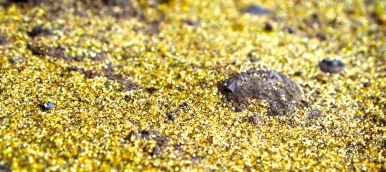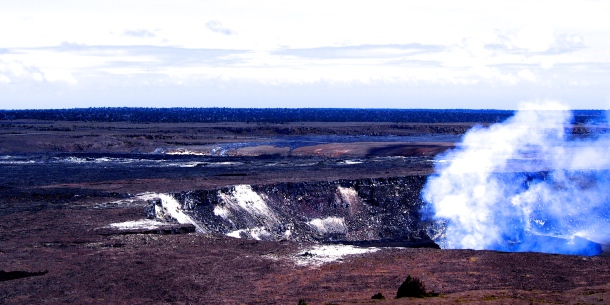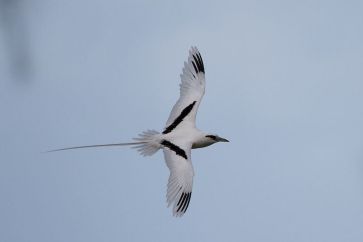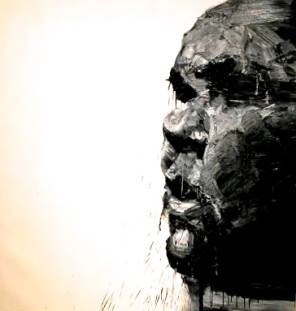I heard a lot about Hawaii from acquaintances who visited the archipelago during summer; they all spoke highly of the food, the vibes, and the people. But it wasn’t until an old friend shared some photographs of her honeymoon that I decided I just had to go. “This is a green sand beach”, the caption read. Green? I’ve seen yellow, white, and black sand beaches, but I hadn’t even heard of green sand beaches before. Why is it green? Is there algae on the sand? I was intrigued.

Green sand at Papakōlea Green Sand Beach in Big Island, Hawaii
It turns out olivine crystals are the reason why the sand appears green. Olivine is a mineral that is common in basalt (lava rock). The cinder cone right next to Papakōlea Green Sand Beach supplies a steady flow of olivine and other minerals to the beach. Since olivine is much denser than other volcanic rock components, the black sand, white sand, and other particles get washed off to sea while the olivine remains. The proportion of green sand gradually increases and eventually becomes the dominant grain on the beach.
As fascinating as green sand is, it turns out there’s a lot more to the archipelago than green sand (duh!). I met friendly locals who were more than happy to share bits and pieces of their Hawaii with me.
#1 Astronomy on Mauna Kea
Mauna Kea – whether you are spiritually or scientifically minded, the name evokes wonder. It has been an important place of worship for the Hawaiian people for as far as records go. The reasons that make Mauna Kea a sacred place are also why the mountain is home to the world’s most advanced astronomical research centers.
Lisa and I went on a stargazing tour to see the research facilities and get a glimpse of why Mauna Kea is so important to the locals. The guide shared all he knew about Mauna Kea with us – natural history, astronomy, and everything in-between.
—
Despite low visibility on the ride to the summit, we spotted a Hawaiian Hawk (‘io or Buteo solitaires) and Chukar Partridge (Alectoris chukar). It was surprising to see the Chukar Partridge (Alectoris chukar) only meters from a hawk. Apparently the Hawaiian Hawk was aware that its dinner was near and was waiting for the right moment to attack.
—
Many factors make Mauna Kea one of the most suitable places for astronomical facilities. Mauna Kea is the tallest mountain on Earth when measured from its oceanic base. The summit has an alpine climate year round and rises above a 600 ft thick tropical inversion cloud layer. This inversion layer effectively acts as a barrier that keeps the moist maritime air and pollution below the summit. Temperature at the summit is very stable due to the mountain’s tropical climate. Light pollution is kept to a minimum because of its remote location and lighting laws that apply stringent rules against the use of bright lights at night.

Mauna Kea Observatories against a backdrop of clouds during sunset
—

Image of moon photographed by Apollo 16
We went stargazing later in the evening. Unfortunately, or fortunately, I was too engrossed by the images of the moon, stars and planets and forgot to take photos. I was particularly impressed when I saw the moon through the telescope. The guide spoke with such passion when he was explaining what we saw to us. I couldn’t help but ask what his coolest fun facts were. “They’re all so cool! How to choose!”, he said. He eventually decided on two: 1. Humans are more similar to space than the Earth, in terms of chemical composition; and 2. Humans lie dead smack bang in the middle of all matter, in terms of size.”
#2 Natural history at Jaggar Museum, a volcanology museum located at the summit caldera of Kīlauea
Mt. Kīlauea has been continuously erupting since May 2018. Magma has been flowing away from the summit magma reservoir and into the eastern rift zone on the island’s southeastern corner. Consequently, Halema’uma’u Crater has been subsiding and the crater walls have fallen on themselves. Artifacts in Jagger Museum have been retrieved and the museum may never reopen. I visited Big Island before the May 2018 eruption and had the privilege to visit Jaggar Museum and observe birds in Halema’uma’u Crater. The short article below was written shortly after my visit.
—
There has been ongoing activity at Halema’uma’u Crater since the series of eruptions in 2008. While the permanent lava lake is relatively benign, the incessant volcanic smog emissions have caused health concerns and various inconveniences to locals near and far. I suspected that all creatures, not just humans, avoided the crater – despite being majestic, it was a barren place, and surely, no creature would want to, or be able to call such a harsh environment home.

Halemaumau Caldera

Volcanic smog in Halemaumau Caldera. The white speck is a White-tailed Tropicbird (Phaethon lepturus)
I was wrong. Within minutes, a small moving white spot caught my eye. It appeared to be a bird, but what would a bird be doing there? There was no food, no fresh air, and the pyroclastic deposits didn’t look comfortable either.
A ranger shared what he knew with me – his story never ceases to fascinate when I retell it.

Photograph of a white-tailed Tropicbird (Phaethon lepturus), taken by Bettina Arrigoni
“That’s the White-tailed Tropicbird, we call it Koa’e Kea in Hawaiian. They’re seabirds that come up here during nesting season to lay eggs. They like nesting in the caldera because the slopes are extremely steep. See how they are almost vertical? It makes it virtually impossible for the rats and the mongooses to get up and take the eggs. But you can never be too sure – that’s why they’re still on guard and circling around. They’re monogamous birds, so they only lay one or two eggs each season and become very invested in rearing the young. One of them stays to incubate the egg while the other gets food – they have a real partnership going on. They’re around all the craters in Big Island”.
#3 History and Culture at Honolulu Museum
Cookie showed me around the Hawaiian section of Honolulu Museum.

Hawaiian flag, sourced from Wikipedia
There was a quilted Hawaiian flag hanging on the wall. I was curious why the Hawaiian flag had a Union Jack. Cookie explained that the Hawaiians were anglophiles, “after James Cook arrived in Hawaii in 1778, the royal family of the Kingdom of Hawaii frequently visited London. The British were very hospitable – they always showed the Hawaiians a good time by throwing lavish parties for their island guests. Their diplomatic relations remained very strong. In honor of their foreign friends, King Kamehameha commissioned a flag in the early 1800’s that incorporated the Union Jack in the canton”.

Painting of Israel Kaʻanoʻi Kamakawiwoʻole taken in Honolulu Museum of Art
I moved along and the painting on the right caught my eye. Cookie explained, “that’s Iz, one of Hawaii’s greatest exports. I’m surprised you haven’t listened to his version of ‘somewhere over the rainbow’. He was so talented and was loved by all – it was really sad when he died. It was a big thing in Hawaii and many fans attended his funeral.” In agreement, a lady admiring the painting nearby added, “his voice touched my soul.”
#4 Social issues
I noticed a lot of homeless in Waikiki when I first arrived, but I didn’t think too much of it. I learnt more about the issue by chance – a friendly shop keeper in a boutique in Chinatown shared some Honolulu history with me. “Honolulu’s Chinatown has changed a lot in recent years. You’ll see the mix of old and new just by walking around. You have the Chinese grocery shops and wet markets alongside modern eateries and newer clothing and lifestyle stores.”
I told her of my Hawaiian experience to date – it was like paradise, if only I was a resident.
She agreed, but cautioned, “this place is not without issues. For one, prices have sky-rocketed. Affluent vacationers don’t realize many things, including housing, have become unaffordable for locals. Homelessness is another big issue, driven in part by the high costs of living. Many people come from the mainland for job opportunities and what not, and end up homeless. Believe it or not, we’ve got the country’s highest rate of homelessness. The government is even considering paying for one way flights for non-local homeless to go home in hope of freeing space in shelters for the local homeless – though reading between the lines, the real objective is probably to ‘clean-up’ Waikiki for tourists. The soup kitchens are all here because it’s a grungier part of town and the real estate is relatively inexpensive. A lot of homeless like to hang around Chinatown because police bother them less here. Not so much now, but tourists used to shy away from this area because it has been historically linked to drug use. The place was rampant with opium dens in the early 1900s.”
#6 At the Okinawa festival
Visiting Okinawa is still on my bucket list. It was great that I happened to be in Honolulu during the Okinawan festival. I listened to some Okinawan folk song and shamisen performances and walked around the stalls.
The Japanese Cultural Centre of Hawaii was helping Japanese Americans trace their family roots. Sato-san, the representative at the stall, explained that the Hawaiian Japanese mainly came from four prefectures in Japan: Hiroshima, Yamaguchi, Fukuoka, and Kumamoto. The first wave of immigrants, the ‘gannen-mono’, were farmers and peasants who went to work on Hawaii’s sugar plantations in 1868. Japanese gradually became one of the largest groups of minorities in Hawaii through a series of migrations (issei). He said Hawaiian Japanese were mostly middle class and have done very well for themselves, getting involved in politics, as well as small to medium sized enterprises. Zippy’s, a fast food chain, was an example of a successful business run by Japanese.
#8 Wading in the waves of Queen’s Beach
I met a lovely lady and her niece while wading in the waves of Queen’s Beach. We started chatting and she explained that her family was there for her aunt’s funeral. The local Hawaiian custom was to spread the ashes of the deceased in the ocean and have a barbecue/swim with family and friends. Her cousin had gone further out on the boat to spread the ashes and the rest of her family was at the grill.
She was very pleased to hear that I enjoyed my time in Hawaii very much, but insisted, “enjoy your time here, but please leave after. The problem with tourists is that they love it too much and then they stay. It has become overpopulated and too expensive for locals.” She asked what I planned for the rest of my trip and I excitedly told her about Chief’s Luau. She was appalled when I told her the price, “that’s Gold Coin (con?) Chief! Come to my place and my family will put on a Luau and feast for you at a fraction of the price!”.
#7 Natural history at Waikiki Aquarium

Photograph of a red footed boobie taken by Gregg Yann
Diane was enthused when she saw me walk by – it was a very quiet afternoon. She was manning the tide-pool tanks and invited me to touch the sea urchins (wana or Echinothrix diadema) and hermit crabs (unauna or Calcinus). The hermit crab crawled over my fingers and reminded me of the feeling I got when fish nibbled at my feet at Fish Spa and Reflexology in Singapore airport.
I don’t remember why, but we started talking about Hawaiian sea birds. She told me her favorite was the red footed boobie (Sula sula). I was intrigued – I had heard of boobies with blue feet (Sula nebouxii), but not red ones. Did the red footed boobies also do the boobie mating dance? Unfortunately, red feet can only dance for a short while, the red footed boobies opted for harsh squawks and blue throat displays instead.
-end-
Check out my book about Japanese crafts: Crafting in Japan – Exploring Japanese crafts through studio visits!
![Crafting in Japan: Exploring Japanese crafts through studio visits by [Florence Lui-King]](https://m.media-amazon.com/images/I/51EYayho1pL.jpg) Summary: Crafting in Japan: Exploring Japanese Crafts Through Studio Visits uses beauty and craftsmanship as a springboard to delve deeper into intriguing aspects of traditional Japanese crafts: heritage, cultural history, and science/engineering. The sustainable materials used and the making processes that transform them into works of fine craftsmanship represent the resourcefulness, creativity, and dedication that artisans have displayed through the ages.
Summary: Crafting in Japan: Exploring Japanese Crafts Through Studio Visits uses beauty and craftsmanship as a springboard to delve deeper into intriguing aspects of traditional Japanese crafts: heritage, cultural history, and science/engineering. The sustainable materials used and the making processes that transform them into works of fine craftsmanship represent the resourcefulness, creativity, and dedication that artisans have displayed through the ages.
The chapters of the book tell the stories of the crafts through studio visits, conversations with artisans in Japanese, and the author’s experience living in Japan as a maker and collector of crafts. Each chapter showcases photographs taken at the artisanal workshops to complement the text.
The book also traces a broader narrative. The government is eager to preserve the craft forms because they represent cultural heritage that date back to the classical era. Many artisans are affiliated with studios that were established in the late Edo or Meiji Period, when the domain system of feudal Japan dissolved upon the adoption of the free market system. Perhaps most intriguing of all is how each craft form draws out different aspects of Japan’s rich cultural history despite charting the same timeline.

